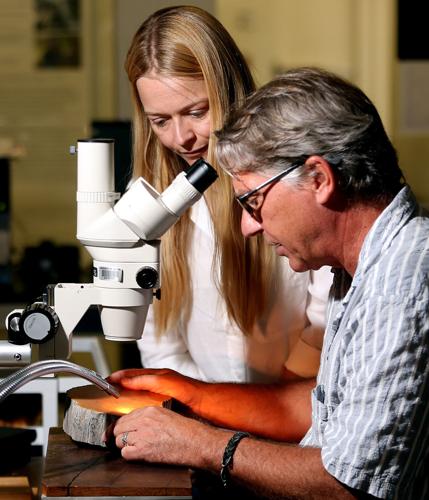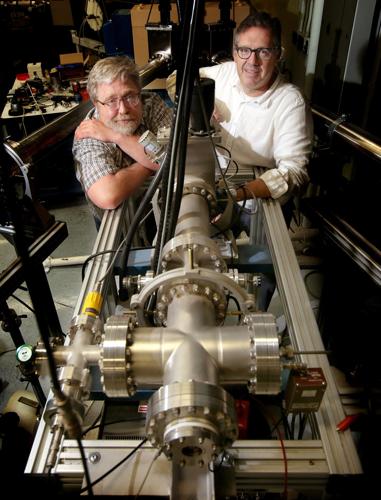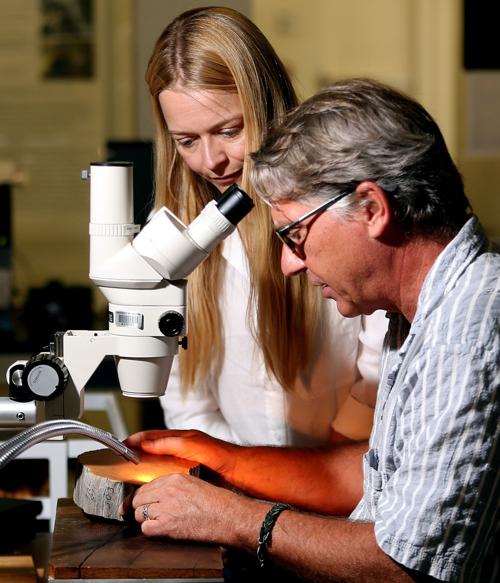The eruption of the Thera volcano more than 3,000 years ago is the one of the largest ever witnessed by humans.
When it erupted on the island of Santorini in Greece, it buried the ancient Minoan civilization under 130 feet of debris. The effects reverberated across the eastern Mediterranean.
New research published by a University of Arizona-led team might have cooled a decades-long debate as to the date of the explosion through the use of an unlikely tool — tree rings.
“It’s about tying together a timeline of ancient Egypt, Greece, Turkey and the rest of the Mediterranean at this critical point in the ancient world — that’s what dating Thera can do,” Charlotte Pearson, assistant professor of dendrochrononolgy at the UA Laboratory of Tree-Ring Research, told the university.
“The volcano erupts and represents one short moment in time,” she said. “If you can date precisely when that moment is, then whenever you find evidence of that moment at any archaeological site, you suddenly have a very precise marker point in time — and that’s really powerful for examining human/environmental interactions around that time period.”
Pearson is the lead author on the study.
Her co-authors from the UA include Gregory Hodgins, Matthew Salzer, Todd Lange, Peter Brewer and Tim Jull. Co-authors from the United Kingdom include David Brown of Queen’s University and Timothy Heaton of University of Sheffield.
Archaeologists peg the eruption date sometime around 1540 B.C. Previous radiocarbon tests, on the other hand, estimate it occurred between 1650 and 1600 B.C. Armed with a new approach to carbon dating, Pearson and her team brought the lines of evidence together to conclude the event fell between 1600 and 1525 B.C.
There are two competing ways to determine the eruption date:
Archaeologists compare artifacts such as pottery excavated from a region with written, dated records. The other method involves radiocarbon dating.
Tiny amounts of radioactive carbon (or c-14) is generated in the atmosphere by nitrogen interacting with charged particles from the space. C-14 is churned in the atmosphere and sprinkled around the world. All living things take up this radiocarbon in their bodies throughout their lives. When a living being dies, intake halts and radioactive carbon declines at a predictable rate, said Hodgins, director of the UA Accelerator Mass Spectrometry Laboratory.
Scientists determine the age of a dead organism based on the amount of carbon-14 remaining when it is found.
But because c-14 levels have fluctuated slightly throughout history, ages determined using radiocarbon dating must be slightly adjusted to determine the calendar age of a sample using what’s called the “calibration curve.” The curve is an international resource that is constantly in the process of being built and refined.

Lab director Greg Hodgins, right, and Todd Lange, research scientist, pose with the carbon-14-detecting section of the the UA’s accelerator mass spectrometer.
Tree rings are so useful for refining the calibration curve because scientists know the age of the tree rings independently by ring counting, Hodgins said. “(The rings) tell us exactly what time in the past we’re working with, then we measure the c-14 content.”
“It’s the equivalent of a modern earth observatory,” said Steve Kuhn, a UA archaeologist not associated with the research. “It’s more than just counting the rings anymore.”
The current calibration curve was constructed using blocks of tree rings that spanned 10 years or more, as large samples were required for radiocarbon dating. But now teams such as Pearson’s are demonstrating that annual measurements are worth pursuing to improve the calibration curve. It helps that technology and techniques now require less wood for measurements.
Pearson and her team analyzed 285 samples of annual growth rings collected by Salzer and Brown. The samples were collected from trees as far as the other side of the world — because radiocarbon levels are global — including Irish oaks in Ireland as well as bristlecone pines from California and Nevada. The rings spanned 1700 to 1500 B.C., a period comfortably encompassing the eruption.
“We had to use tree rings from the best, most solid tree-ring chronologies where there was no doubt that each year was going to represent the exact year in time we thought it represented,” Pearson said.
The team constructed a new section of calibration curve using these rings in more detail than ever before. They then compared their resulting carbon-14 levels against existing measurements of materials from Santorini, including seeds and the branch of an olive tree, Pearson said.
The levels matched multiple places within the 75-year window from 1600 to 1525 B.C.

This laboratory houses the UA’s accelerator mass spectrometer, which is used to determine the age of dead organisms based on the amount of radioactive carbon they retain.
The team also used the tree rings in a more traditional way.
Thera ejected about 80 cubic kilometers of debris into the atmosphere, Hodgins said. The dust cut down sunlight, lowering global temperatures. The trees sampled respond to cold by growing narrower rings.
Salzer found four years of narrow ring growth that fit within the range of dates estimated by carbon dating, Pearson said.
So what does this all mean?
“This apparent discrepancy between the archaeological evidence and the (old) radiocarbon dates might not be real,” Kuhn said. “The radiocarbon dates have an ambiguity that you can’t resolve. (They showed) the method is not very precise in that time range because of fluctuations in the amount of c-14 in the atmosphere.”
To get a more precise date, Pearson said, researchers need more measurements from other records such as ice cores, lake sediments, or cave sediments, for example.
“But there’s this exciting new movement towards improving the calibration curve and making it better,” she said.
If the team’s results can be replicated by others and the changes to the calibration curve are accepted, then it will better inform anyone dating artifacts between the dates archaeologists looked at, she said.
All of the researchers stressed that this work was made possible by the fact that the UA has both a world-class tree ring lab and an accelerator mass spectrometer to measure carbon-14.







